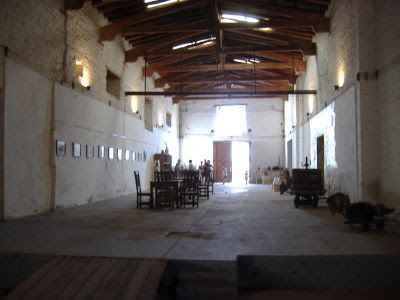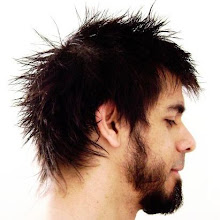San Rafael is a city of 170,000 in the center-south of Mendoza Province. It's modern, and it has nearly no old architecture or historical buildings. I wouldn't call it a tourist trap, but in truth the town itself is not worth many visits. You can find wide avenues, supermarkets, icecream parlours, gift shops, a few parks, and tourist agencies. The real San Rafael is outside the city: the Atuel River, the lakes, the mountains.
Tierrasoles Hostel is not your place if you don't care for young, active people. It looks and feels like a huge student residence: lots of beer and Fernet con Coca flowing in the tables, noisy groups of hormone-crazed 20-somethings, communal showers, packed rooms, people who stay up late at night and like to go partying, and an assortment of spoiled brats (usually porteños) with lots of time and daddy's money to spend. The communal showers were OK; the rooms were acceptable, if cramped; the breakfast medialunas were awful. The service is good, but quite logically it's not very personal.
The night after we arrived, the reception guy, Cristóbal, approached us expansively, telling us about a disco called La Barra, set up along a dam about an hour from the city. Let's party, whoo!!, drink Fernet in the van with the rest of the passengers, talk up the hostel's girls, he proposed. So we went. Bad mistake. La Barra is your classical all-purpose disco, which doesn't cater for anyone in particular, and so needs to pack each and every musical trash currently en vogue in a potpourri. The music was as varied as it was awful (with the exception of 45 minutes of classical rock nacional which me and one of my friends enjoyed wholeheartedly, knowning the rest would be worse). The local girls were too young and were mostly taken; the local boys were also young, ostentatiously gym-goers, and drunk. The place was uncomfortably packed and the drinks were not as cheap as they should have. (Do I sound like a bitter old man already? I'm 30 and I'm always fine in the company of 20-somethings. But I don't like my fun being mis-planned by someone else.) Worst of all, we couldn't leave; we were in the middle of nowhere and the van would not depart until 5:30 AM.
Fortunately La Barra was not our best experience in San Rafael and was soon forgotten and turned into one of those funny bad times (the way you remember when you broke your arm when you were 12). We had come for landscapes and water, and we got plenty. We did rafting in the Atuel River, which is level II only, and I bathed in Los Reyunos, formerly a private country club, now a private camping site with pools and beaches.
Being in Mendoza we couldn't skip the wineries, so we visited two: Bianchi and La Abeja. Bianchi, founded by the obviously megalomaniacal Enzo Bianchi, has a huge estate just outside San Rafael, with buildings which look like Venetian houses (according to our guide), a fountain, and statues. They use top technology and produce quality old wines, champagne and sparkling wines. We spotted a typical unsophisticated Argentine tourist buy two bottles of rosé New Age, an overpriced bubbly soft wine that is marketed to young adults and which you can buy in any supermarket in town... You can't beat us at sarcasm. The poor guy was about 50, he had a prominent beer belly and wore a sleeveless T-shirt; he had no idea what he was doing, and we really skinned him alive. La Abeja was founded by San Rafael's founder, Rodolfo Iselín, a French immigrant who came to make wine and found that there were no workers and no railway to carry away his produce; so he got Italian and French families to live in his land, basically as serfs, and President Julio A. Roca to fund a railway to reach Rosario and Mendoza, so that the wine wouldn't have to endure months of travel in slow carriages. The winery is owned by a different family now, and it produces a small amount of wine of several varieties. I tried and bought a young Tempranillo-Bonarda blend and a Chenin Blanc. This visit was much more interesting than Bianchi — the old traditional flavour was better, the guide did not act like a robot, and we got a history lesson for free and a personal conversation with the wine expert.
La Abeja was founded by San Rafael's founder, Rodolfo Iselín, a French immigrant who came to make wine and found that there were no workers and no railway to carry away his produce; so he got Italian and French families to live in his land, basically as serfs, and President Julio A. Roca to fund a railway to reach Rosario and Mendoza, so that the wine wouldn't have to endure months of travel in slow carriages. The winery is owned by a different family now, and it produces a small amount of wine of several varieties. I tried and bought a young Tempranillo-Bonarda blend and a Chenin Blanc. This visit was much more interesting than Bianchi — the old traditional flavour was better, the guide did not act like a robot, and we got a history lesson for free and a personal conversation with the wine expert.
We stayed in San Rafael four days; next we went to Malargüe... the best part of the journey. I'll tell you about that tomorrow.
22 January 2007
San Rafael
at
2:32 PM
![]()
Labels: argentina, Argentine history, hostel, mendoza, san rafael, travel, vacations, wineries
Subscribe to:
Post Comments (Atom)


No comments:
Post a Comment
Note: Only a member of this blog may post a comment.